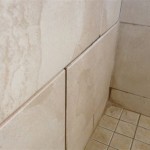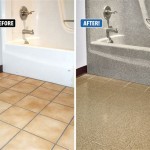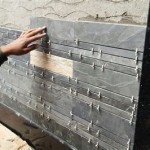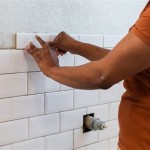The Best Way to Remove Ceramic Tile From a Concrete Slab
Removing ceramic tile from a concrete slab can be a demanding task, often involving significant time and effort. The process requires careful planning, the right tools, and a systematic approach to minimize damage to the underlying concrete. This article provides a comprehensive overview of the most effective methods for tile removal, outlining the necessary equipment, safety precautions, and step-by-step instructions.
The bond between ceramic tile and concrete is typically strong, achieved through the use of thin-set mortar. This mortar creates a durable connection designed to withstand daily wear and tear. Consequently, removing the tile without damaging the concrete necessitates a method that weakens or breaks this bond without exerting excessive force on the concrete surface. Several techniques exist, each with its own advantages and disadvantages depending on the size of the area, the type of mortar used, and the desired outcome for the concrete slab.
Preparation is Key: Protecting Yourself and the Work Area
Before commencing any tile removal project, thorough preparation is crucial. This involves protecting oneself with the appropriate safety gear and safeguarding the surrounding work area from dust and debris. Safety glasses, a dust mask or respirator, work gloves, and knee pads are essential. The breaking of ceramic tile can create sharp fragments that can cause eye injuries, respiratory irritation, and skin lacerations. Knee pads are crucial for comfort and protection during the prolonged kneeling or crouching that the task often necessitates.
The work area should be isolated using plastic sheeting and painter's tape. This prevents dust from spreading to other parts of the house. It is also advisable to close off air vents in the room to minimize the distribution of airborne particles through the HVAC system. Remove any furniture or obstacles from the area to provide ample workspace and prevent accidental damage. Consider laying down drop cloths to protect the flooring in adjacent rooms if complete isolation is not possible.
Furthermore, before beginning, inspect the area and identify any potential hazards, such as electrical wiring or plumbing lines embedded in the concrete. Mapping out the location of these utilities beforehand can prevent accidental damage and potential injury. If unsure about the location of utilities, consult with a qualified professional.
Effective Tile Removal Techniques
Several techniques are commonly employed for removing ceramic tile from concrete slabs. Each method has its own advantages and application scenarios. These include using a manual hammer and chisel, employing a floor scraper, utilizing a demolition hammer, and leveraging the power of specialized tile removal tools.
Manual Hammer and Chisel: This is the most basic and often the most time-consuming method. It involves positioning a cold chisel at the edge of a tile or along a grout line and striking the chisel with a hammer to break the tile’s bond with the mortar. This method is best suited for small areas or for removing individual broken tiles. While it requires minimal investment in tools, it demands considerable physical effort and is prone to leaving behind mortar residue on the concrete.
When using a hammer and chisel, hold the chisel at a low angle to the tile surface to avoid chipping the concrete. Apply steady, controlled blows to the chisel to gradually weaken the mortar bond. Work slowly and methodically, focusing on breaking the bond rather than shattering the tile into fragments. Wear safety glasses to protect your eyes from flying debris.
Floor Scraper: A floor scraper is a tool designed specifically for removing flooring materials, including ceramic tile. It typically consists of a long handle attached to a sharp blade. The scraper is used to slide under the tile and pry it away from the concrete. Floor scrapers are available in manual and powered versions. Manual scrapers require significant physical exertion, while powered scrapers offer increased efficiency and reduced fatigue.
When using a floor scraper, start by removing the grout around the tiles. This will allow the scraper blade to slide more easily under the tile. Apply consistent pressure to the handle, pushing the scraper forward and under the tile. If the tile proves difficult to remove, try tapping the scraper blade with a hammer to help it penetrate the mortar bond. Ensure the blade remains sharp to maximize efficiency and minimize damage to the concrete.
Demolition Hammer: A demolition hammer, also known as a jackhammer, is a powerful tool that can quickly remove large areas of tile. This method is best suited for large-scale projects where speed is a priority. However, it requires caution to avoid damaging the concrete. Demolition hammers can be rented from most tool rental centers.
When using a demolition hammer, select a chisel attachment that is appropriate for tile removal. Start by positioning the chisel at the edge of the tiled area and applying gentle pressure. Allow the hammer to do the work, gradually breaking the tile’s bond with the mortar. Avoid applying excessive force, as this can easily damage the concrete. Maintain a consistent angle and movement to ensure even removal. Wear appropriate hearing protection, as demolition hammers generate significant noise.
Specialized Tile Removal Tools: Several specialized tools are available specifically for removing ceramic tile. These tools often incorporate features such as adjustable blades, vibration settings, and dust collection systems. They can significantly improve efficiency and reduce the risk of damage to the concrete. These tools can be a worthwhile investment for frequent tile removal projects.
Before using any specialized tool, carefully read the manufacturer’s instructions. Experiment with different settings to find the optimal combination of power and control. Regularly inspect the tool for wear and tear, and replace any worn or damaged parts. Maintain a steady grip and controlled movements to ensure safe and effective tile removal.
Cleaning and Preparing the Concrete Slab
Once the ceramic tile has been removed, the concrete slab will likely have residual mortar and adhesive. Removing this residue is essential for preparing the surface for new flooring. Several methods can be used to clean the concrete, including scraping, grinding, and chemical stripping.
Scraping: A floor scraper or a stiff-bladed putty knife can be used to manually scrape away loose mortar and adhesive. This method is effective for removing small amounts of residue. It is important to wear gloves to protect your hands and to use a dust mask to avoid inhaling airborne particles.
Grinding: A concrete grinder equipped with a diamond grinding wheel can be used to remove stubborn mortar and adhesive. This method is more aggressive than scraping and requires caution to avoid damaging the concrete. Concrete grinders can be rented from most tool rental centers. Wear safety glasses, a dust mask, and hearing protection when using a concrete grinder.
Chemical Stripping: Chemical strippers are designed to dissolve or soften mortar and adhesive, making it easier to remove. These strippers are available in various formulations, each designed for specific types of adhesives. It is important to carefully read and follow the manufacturer’s instructions when using chemical strippers. Ensure adequate ventilation and wear appropriate protective gear, including gloves, eye protection, and a respirator.
After removing the mortar and adhesive, thoroughly clean the concrete slab to remove any remaining dust and debris. This can be done by sweeping, vacuuming, or washing the surface with a mild detergent solution. Allow the concrete to dry completely before installing new flooring. Inspect the concrete for any cracks or damage and repair them as needed before proceeding with the next step.
In summary, successfully removing ceramic tile from a concrete slab requires careful planning, the right tools, and a systematic approach. By following the steps outlined in this article, individuals can effectively remove tile while minimizing damage to the underlying concrete and ensuring a clean and prepared surface for new flooring.

How To Remove Tile From A Concrete Floor

The Best Way To Remove Thinset From A Cement Foundation House Of Hepworths

Removing Tile And Thinset From Concrete Sawdust Girl

How To Remove A Tile Floor Complete Step By Guide Apollo

How To Remove Floor Tiles From Concrete Our Guide

How To Remove Tile Floor From Concrete

The Best Way To Remove Thinset From Concrete House Home

How To Remove Tile From Concrete Floor Central Florida Dust Free Flooring Demo Removal Llc

Dust Free Thinset Removal

The Best Way To Remove Thinset From A Cement Foundation House Of Hepworths
Related Posts








